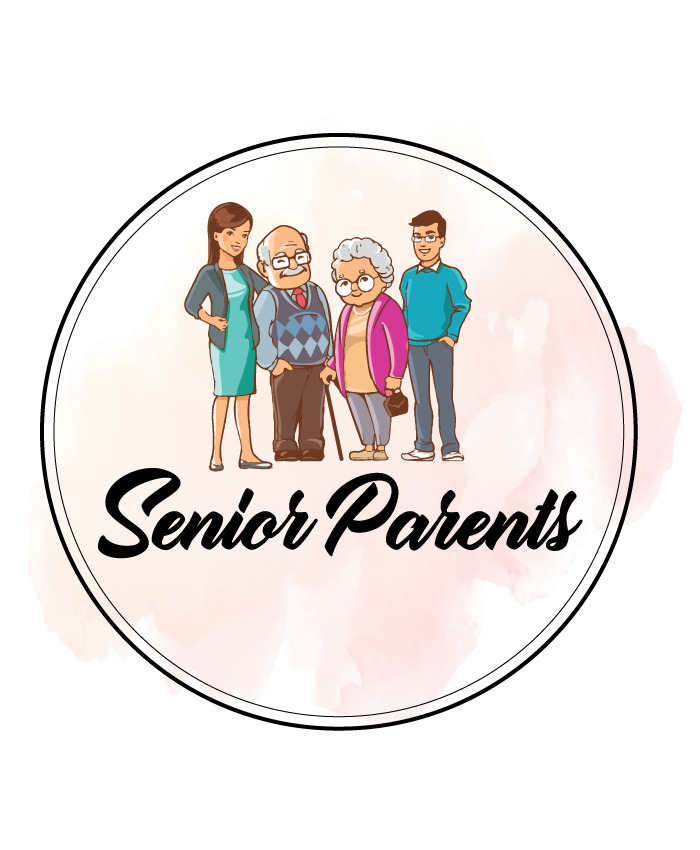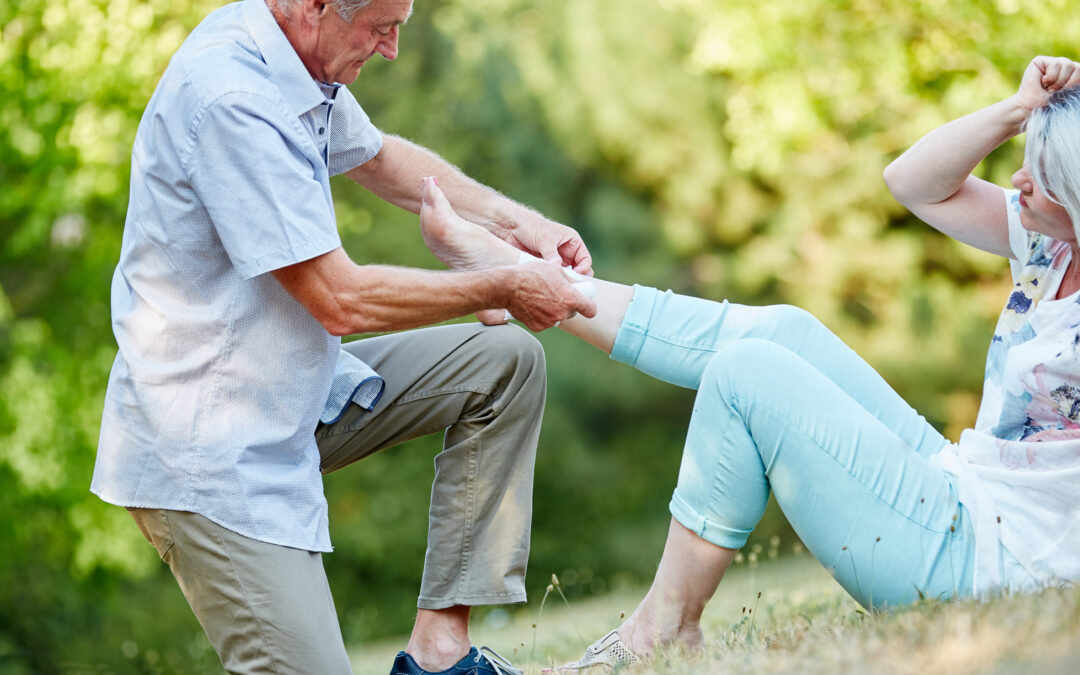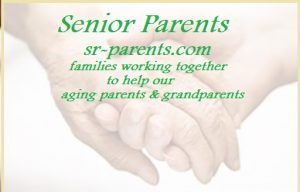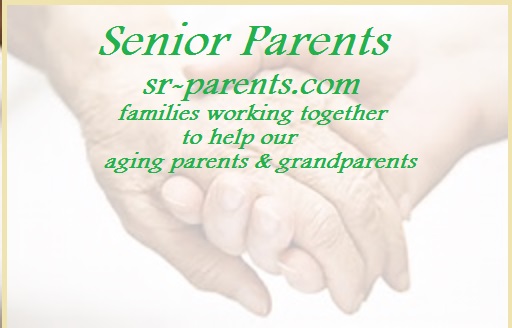Foot problems in elderly can make your loved ones housebound, immobile, or even worse. Read to learn more about common foot problems in elderly and how to prevent them.
As our loved ones get older, many of us begin to think about their physical health. We are more concerned about their overall health and well-being. However, one of the most common problems we often overlook is their feet. Getting older often increases wear on elderly feet, injury, and deformation.
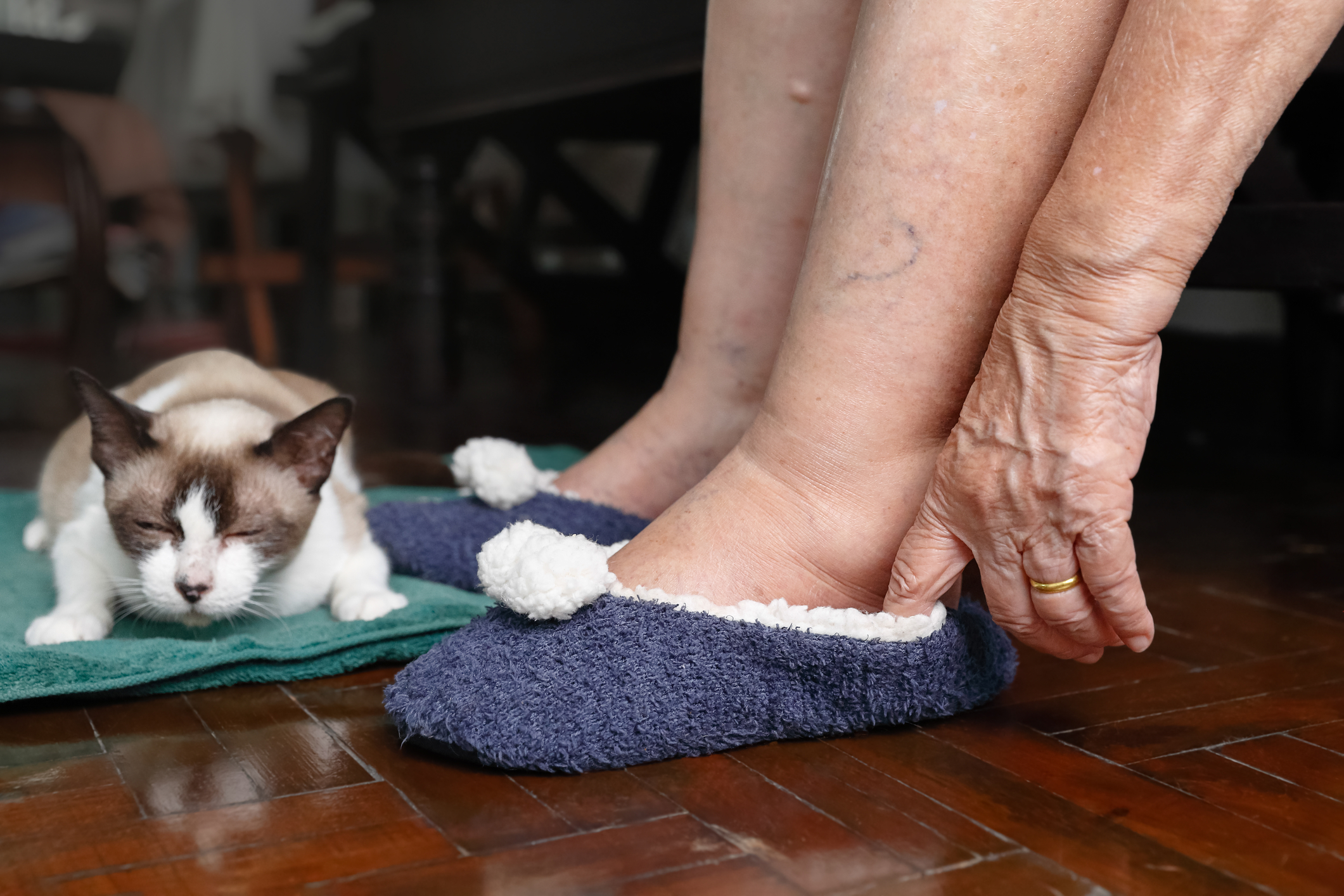
Foot Problems in Elderly
It is essential to understand that the feet of your elderly loved ones are their core support system, and unhealthy feet can make them housebound, immobile, or even worse. So, knowing about preventive care and non-surgical procedures is an excellent option to prevent common foot problems in elderly. It includes foot pain at night in elderly or other heel problems in elderly. Understanding what care your feet need can lead to healthy feet and mobility as you or your loved one age.
Moreover, aging feet need extra care, primarily due to the increased risk of chronic foot problems. Additionally, aging foot problems like heel pain in elderly people can increase the risk of falls, which means good foot care is crucial to reducing the risk of falling.
Contents
What Causes Foot Problems in the Elderly

Foot Problems in Elderly
As we age, bone weakness and normal joint wear and tear can lead to foot pain. It is essential to know that seniors have thinner skin with less elasticity, especially on their feet. However, knowing the causes of foot problems in elderly can help you prevent them. Here are a few culprits that can cause foot or heel pain in the elderly:
Improper Footwear
Improper footwear is among the most common causes of foot problems in elderly. Most seniors eschew improper and fashionable footwear in favor of shoes that offer excellent arch support and traction. However, just because their footwear looks practical doesn’t mean they are a perfect fit for their feet. The best and proper footwear for your senior loved ones should have solid, flexible soles along with generous arch support.
Moreover, when choosing the right type of shoes for your elderly loved ones, ensure that they allow a generous range of motion for the mid-portion of their feet. Furthermore, if it is hard for you or your loved ones to find the right pair of shoes, it is highly recommended to consult your podiatrist and acquire custom orthotic footwear.
Common elements for senior footwear include:
1. Soles
When buying shoes for your loved ones, ensure that the mid-sole is sturdy but not too flexible for better stability. Remember that footwear that bends easily can cause foot pain in the elderly or twist their foot or ankle. On the other hand, hard, sturdy soles are slip-resistant, have a good tread, and offer excellent stability.
2. Size
Proper footwear size is another significant element to consider. Shoes that are too big can cause slip and slide, contributing to the loss of balance or a fall in the elderly. Similarly, shoes that are too tight can also cause foot problems elderly, making it hard for your loved ones to walk and focus on each step.
3. Closed Heels
In addition to proper footwear size, ensure to wear closed-heel shoes. They are great for providing excellent stability and preventing heel pain in the elderly. Moreover, open-heeled shoes do not fit snugly enough, which can cause instability or balance loss, increasing the risk of falls.
4. Weight
Keep in mind that heavy footwear can be uncomfortable for weak seniors. It can be challenging to lift their feet, forcing them to shuffle when walking, increasing the risk of falls. While low-heel shoes are great for better stability, ensure that the footwear you buy is lightweight.
Moisture
Since seniors have thinner and less elastic skin, mainly on their feet, it can make their feet more susceptible to blisters and painful rashes, causing foot pain at night in the elderly. So, choosing footwear should have generous ventilation to prevent moisture buildup is essential.
In this regard, shoes that have interior linings are great for absorbing moisture. Moreover, wearing such footwear also helps limit the likelihood of fungal infections, chafing, and general irritation of the feet.
Untreated Arthritis
Untreated arthritis is another reason that could cause various foot problems in elderly. One of the effective ways to prevent or limit foot pain in the elderly is to learn how to alleviate the symptoms of arthritis. If joint inflammation is an issue, ensure to avoid prolonged periods of standing.
Moreover, untreated arthritis affecting the feet often points out the existence of untreated infection in the body. So, it is highly recommended to have a doctor’s checkup for signs of any hidden infection.
Stress Fracture
As we age, our bones get weaker, so even a slight misstep or fall could cause a stress fracture in seniors’ feet, which could cause foot pain in the elderly while standing or walking. Some practical ways to prevent such issues include plenty of bone-strengthening vitamin D and calcium in your loved ones’ diets, daily exercise, and balance training.
Common Foot problems in elderly
1. Plantar Fat Pad Atrophy
While most seniors fight the accumulation of fat and weight, others can lose padding in their feet. Pads on the heel and balls of elderly loved ones are one of the most common causes of heel pain in the elderly, making each step a painful experience.
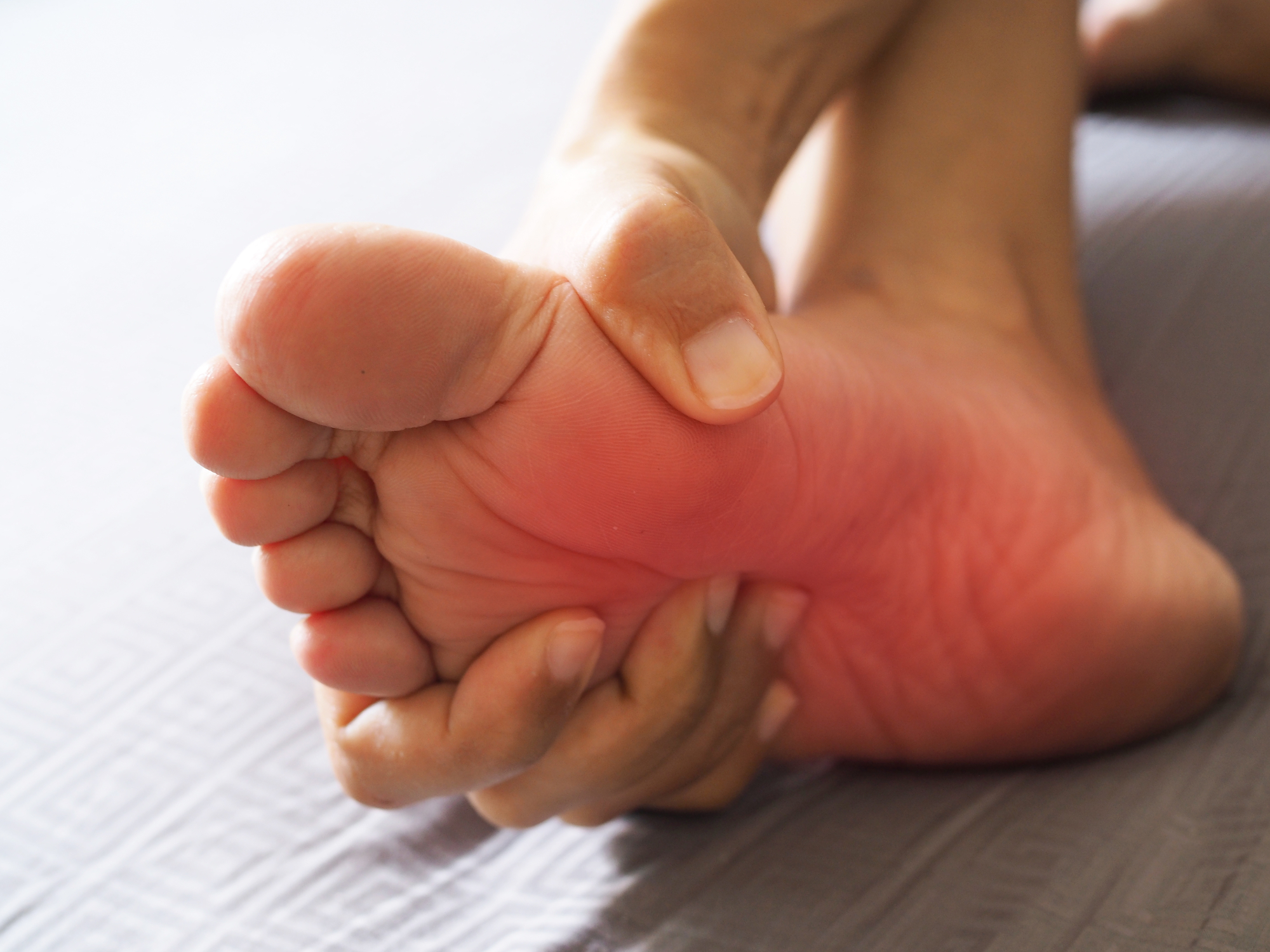
fat pad
Plantar fat pad atrophy means thinning of the fat pads on the bottom of the feet. These fat pads act as a cushion to our feet’ bones while also helping to absorb forces as we take on heavy loads. Without these pads, our feet’ bones can be exposed to more pressure, making our feet more prone to injury.
The progressive thinning of fat pads can occur as we age. Other common causes that can cause plantar fat pad atrophy in seniors include:
- Diabetic neuropathy.
- Certain medications.
- Genetic predisposition.
- Abnormal position of feet bones that damages fat pads.
- Footwear puts more pressure on the feet.
Symptoms of Plantar Fat Pads Atrophy in Elderly
When suffering from plantar fad pads, the bones of your loved ones will start taking on heavier loads. Your feet will be unable to absorb shocks as effectively, causing:
- Foot pain at night in elderly.
- Heel pain in elderly.
- Formation of callus.
Preventive Measures
It is worth noting that thinning and plantar fat pad damage is irreversible. However, specific treatments, such as providing shock absorption and missing cushioning, can improve the condition. It involves a combination of proper footwear and cushioning orthotics. Moreover, limiting activities that worsen the symptoms can also help minimize the onset of sore symptoms.
Furthermore, depending on your daily activities, symptoms, and cause of plantar fat pad atrophy, your podiatrist may also tailor a treatment for you.
2. Cracked Heels (Heel Fissures)
The soles of our feet bear the most significant force throughout our life. They have thick skin with added fat padding. However, skin becomes more susceptible to cracking when it becomes dry. While it is not an uncommon issue in people of any age, it can be a severe condition, leading to heel pain in the elderly, severe discomfort, and hampering your or your loved ones’ daily routine.
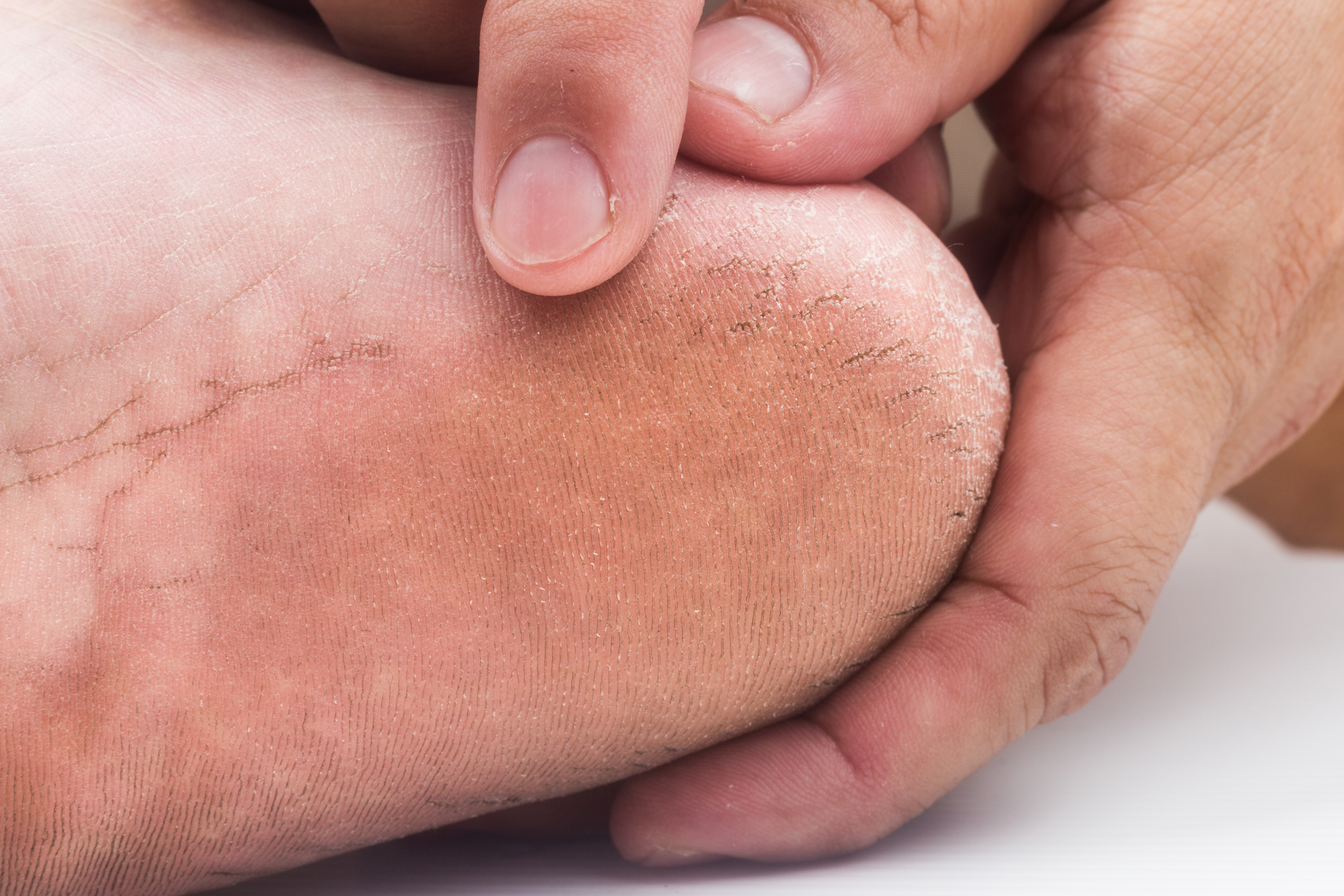
cracked heels
Cracked heels or heel fissures that can develop due to age-related changes in the body are especially a more common problem in older adults. While heel fissures usually occur in the skin of the heels, these deep openings can also occur in other parts of the feet.
Apart from being severely painful and leading to bleeding, cracked heels in the elderly can also cause extreme foot pain at night in elderly, while also increasing the chances of infection settings on the feet sole.
Some common causes of cracked heels in the elderly include:
- Dry skin.
- Standing for prolonged periods.
- Wearing open-back footwear.
Symptoms of Cracked Heels in Elderly
Symptoms of cracked heels in the elderly can range from mild to severe. A few possible symptoms include:
- Thickening of the heel skin around the cracks.
- Yellow or brown discoloration of the skin, indicating the presence of callus.
- Splitting of the skin around the heels.
- Visible cracking on the heels.
Preventive Measures
One of the effective ways to treat cracked heels or heel fissures is by reducing the pressure on the feet. In this regard, ensure to wear supportive footwear that should be soft and fit cozily. Additionally, placing counter pads on the affected areas can help reduce pressure on the soles.
You can try the at-home treatment if you or your loved ones have mild symptoms. For instance, applying a two-application approach that involves thick moisturizers thrice a day can ease the conditions. Moreover, preparations made with petroleum, ceramides, almond, coconut, or sunflower oil can also help heal the soles.
3. Corns and Calluses
Among other common foot problems in elderly, corns and calluses is another painful problem that could disturb your or your loved one’s daily routine. They have thickened layers of skin around sensitive areas of the feet that could cause pain.
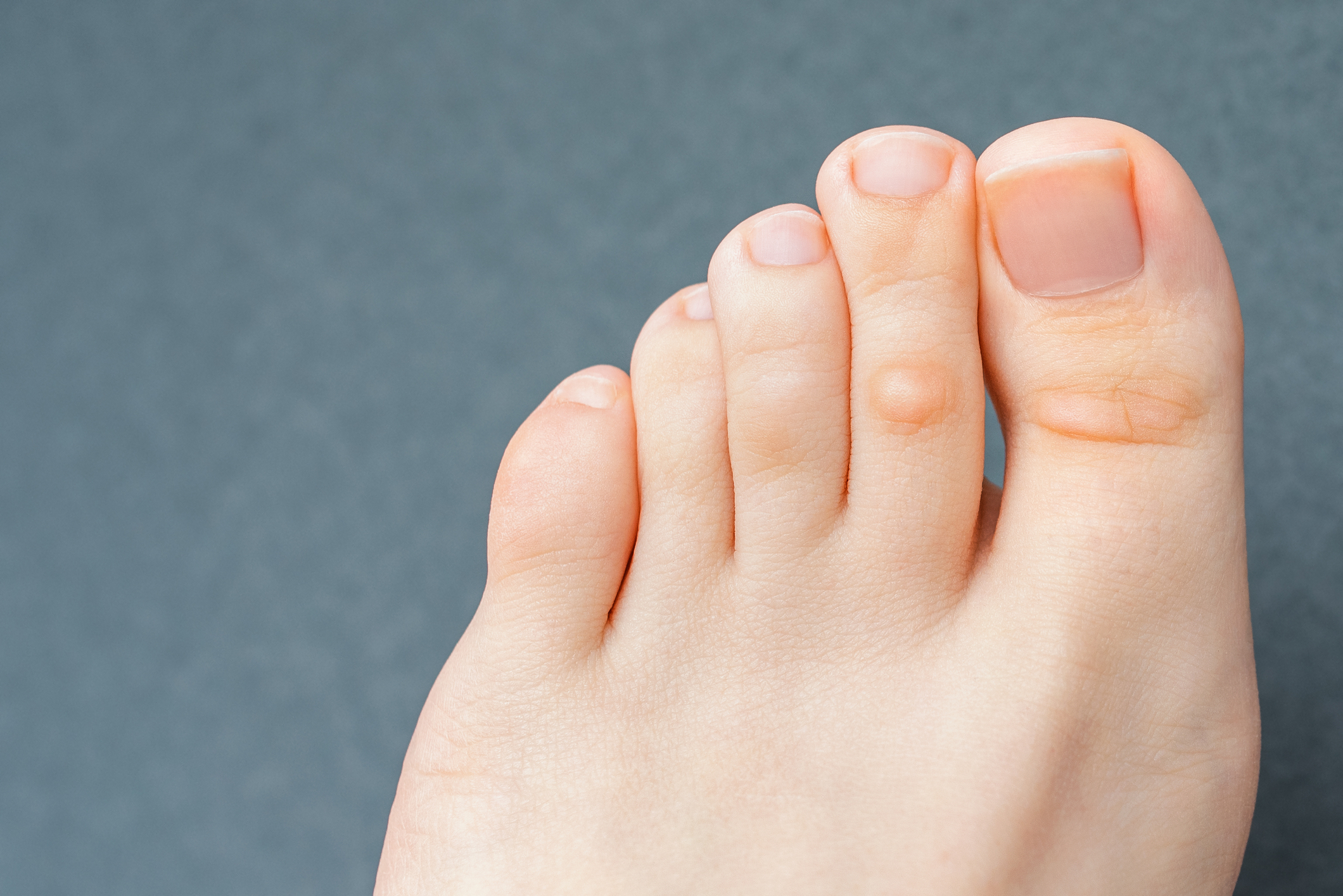
corns and calluses
Corns are tiny areas of skin that can become hardened, mainly due to a lot of pressure on that area. There are two types of corns – hard corns and soft corns.
Hard corns mainly occur on the top or outer side of smaller toes since these areas are where ill-fitting footwear tends to rub the most. On the other hand, soft corns usually occur between the toes, commonly between the 4th and 5th toes. They are soft due to the sweat between the toes, causing the risk of infection.
Moreover, calluses are usually bigger than corns and have a less-defined edge. They generally form on the foot’s outer side over the bony area and underneath the toes. Since that’s the most weight-bearing area of the feet, they can cause foot pain in the elderly.
While the most common cause triggering the problem is ill-fitting footwear, other factors such as improper walking motion can also contribute to corns and calluses.
Symptoms of Corns and Calluses in the Elderly
- A hardened raised bump.
- The thick rough area around the sensitive skin of the feet.
- Tenderness or foot pain at night in elderly.
- Dry, waxy, or flaky feet skin.
Preventive Measures
If you or your loved ones are experiencing corns and calluses, it is best to seek expert advice for diagnosing and treating foot disorders. Cutting corns yourself, especially if you’re a senior or suffering from diabetes, can worsen the problem.
Moreover, corns and calluses caused by ill-fitting footwear can be treated by wearing shoes with soft upper and lower heels and plenty of room for the toes. Proper footwear can also reduce rubbing and friction on the feet’ skin.
Furthermore, depending on the corns or calluses area on the feet, cushioning pads and shoe insole can also help. For instance, if you have calluses under the feet, wearing soft shoes will cushion that area, helping to heal the callus. Similarly, if your elderly loved ones have corns between the toes, wearing a special sleeve around the toes can ease the pressure.
In addition, using a special toe splint will also help keep toes apart, allowing the corns between the toes to heal.
4. Ingrown Toenails
Ingrown toenails involving the nails curving down into the surrounding skin is a common discomfort. It occurs when a side of the nails curls down, growing into the skin around the nails. While it can occur in any toe, the most common point is the big toe.
Ingrown toenails can become infected, and if left untreated, they can spread and infect the underlying bone of the feet. Like many other foot problems in elderly, one of the primary causes is too tight footwear, socks, and tights that could crowd the toes, putting pressure on toenails. The condition can worsen, causing foot pain in the elderly and disturbing their daily routine.

ingrown toenail
Cutting toenails not straight across or too short can also trigger the problem. Similarly, an injury to the toe, picking the corners of toenails, sweaty feet, certain medical conditions, etc., can also cause ingrown toenails.
Symptoms of Ingrown Toenails in Elderly
A few ingrown symptoms include:
- Inflamed skin.
- Foot pain at night in elderly.
Preventive Measures
There are various ways that can prevent or ease ingrown toenails in the elderly. One of them includes trimming your or your elderly loved one’s toenails straight across. Whether you have a pedicure or trimming nails, ensure to trim them straight across. Additionally, in case of poor blood circulation to the feet, it is recommended to see your podiatrist immediately.
Moreover, keeping your or your senior loved one’s toenails at a moderate length can help prevent the problem. Similarly, wearing protective footwear can also help ease ingrown toenails.
5. Poor Blood Circulation to the Feet
Poor blood circulation to the feet can also cause foot problems in elderly. There are many factors that can contribute to and worsen the condition. It includes obesity, a sedentary lifestyle, smoking, diabetes, blood clots, and age. This is one of the most painful feet problems, causing extreme discomfort and foot pain in the elderly.
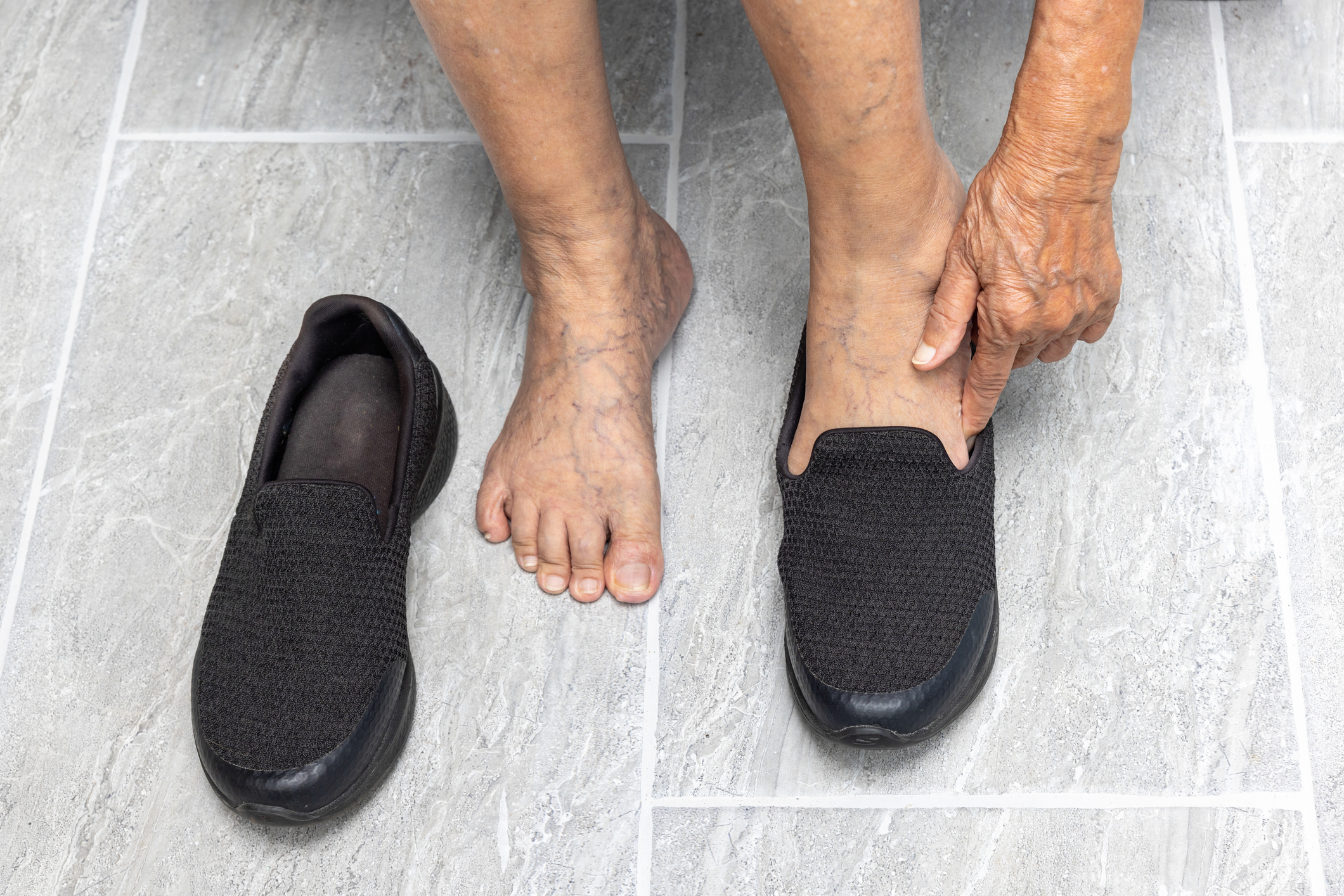
poor circulation to feet
It involves inadequate blood circulation to arteries which supply blood to the arms and legs, veins that carry blood to the heart, and the lymphatic system, which drains tissue fluids. However, apart from the feet, the condition can affect the whole body, including arms, hands, legs, etc.
Moreover, while poor blood circulation isn’t a condition in itself, it can be caused by various conditions. The most common culprits include diabetes, heart disease, arterial issues, and obesity.
Symptoms of Poor Circulation in the Elderly
Some common symptoms of poor blood circulation to the feet include:
- Feet muscle cramps.
- Heel pain in elderly.
Preventive Measures
Various simple ways can help you or your elderly loved ones prevent poor circulation in the feet. For instance, exercising regularly or just a simple walk can make a world of difference. Similarly, a healthy diet with plenty of fruits and vegetables can improve the condition.
Moreover, exercises, such as elevating your legs above your heart for half an hour daily, can improve circulation in the feet. Additionally, if you or your elderly loved one is suffering from circulation, make sure to seek the help of your podiatrist. A simple, painless test, “duplex ultrasound,” will help you determine if you have poor circulation as well as the severity of your condition.
6. Fungal Infections
Fungal infections have become a common foot problem in the elderly. An athlete’s foot (tinea pedis) is a contagious fungal infection that severely affects the skin on elderly feet. Especially in older adults, a weak immune system and less elastic skin can invite more fungal infections.
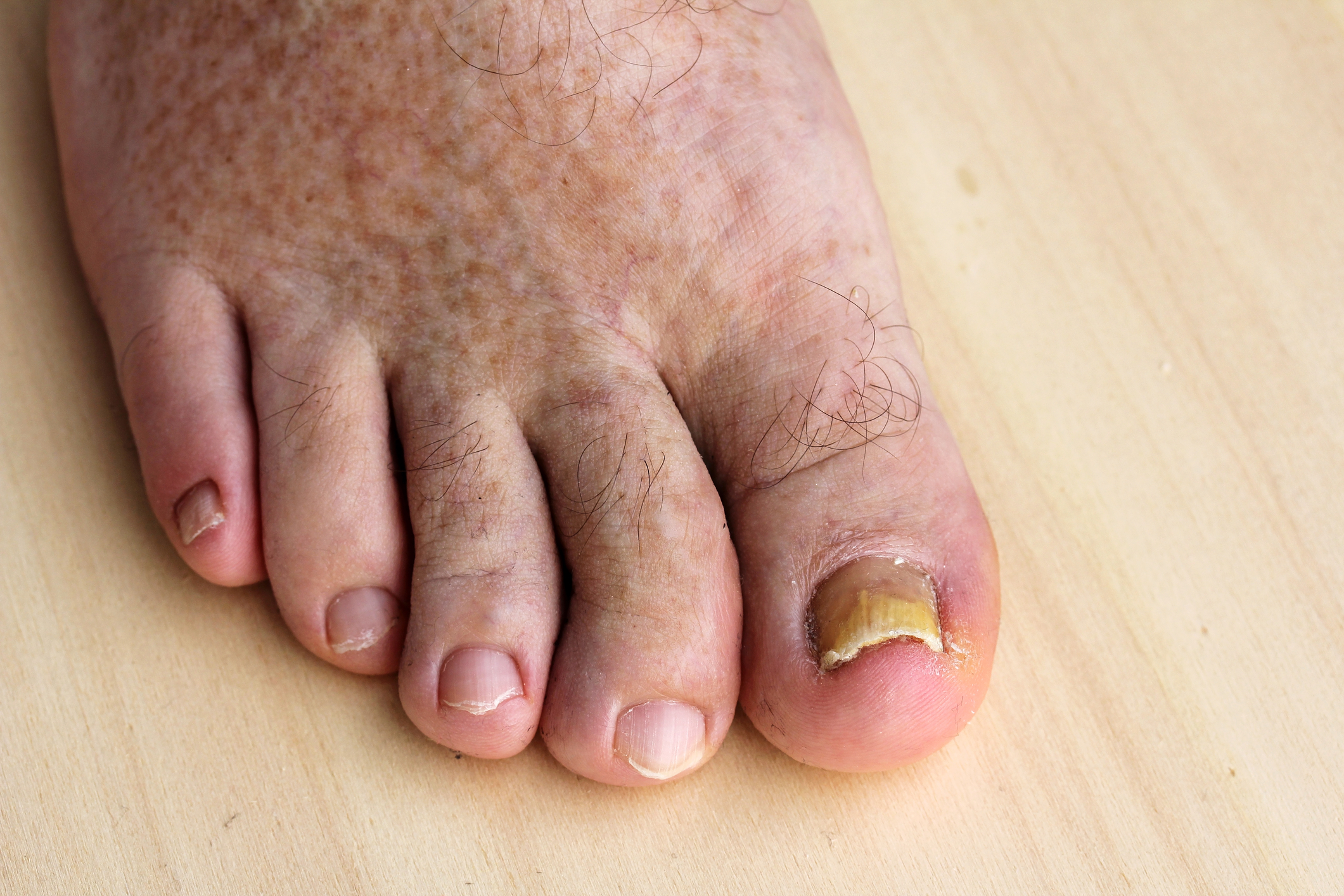
fungal infectoin
If left untreated, foot fungal infections can get worse, spreading to the toenails. While it is not a serious issue, it can cause severe foot pain at night in the elderly and is hard to cure, especially if you or your elderly loved ones have diabetes or a weaker immune system.
While tight-fitting footwear is a common culprit that can cause fungal infection, skin disorders in the elderly and damp socks can also trigger the condition. Moreover, contact with contaminated surfaces like floors and towels can cause fungal infections.
Symptoms of Fungal Infection in the Elderly
An athlete’s foot can upset one of both feet. A few symptoms of fungal infection in the elderly include:
- Itchiness after taking your footwear or socks.
- Peeling or cracked skin between the toes.
- Burning or stinging feet.
- Inflamed feet skin that may appear reddish.
Preventive Measures
A few simple things that can help you prevent fungal infection in the elderly include:
- People with fungal infections should avoid tight footwear. Instead, wearing sandals will help you let your feet air out.
- Using warm, soapy water for thoroughly washing feet daily, especially between the toes, can prevent fungal infection. Moreover, a medicated powder like Gold Bond and Tinactin is also beneficial.
- If you or your loved ones are more prone to fungal infection, ensure to change your socks daily. Moreover, in case of sweaty feet, wear moisture-wicking socks.
- Wearing waterproof sandals, especially around public places, locker rooms, showers, etc., can also help prevent fungal infection.
7. Hammertoe
Hammertoe is one of the common foot problems in elderly. It is a disorder that usually affects the second or third toe. Additionally, hammertoe in the elderly can also upset the middle toe of the joint, causing it to bend down and resemble a hammer.
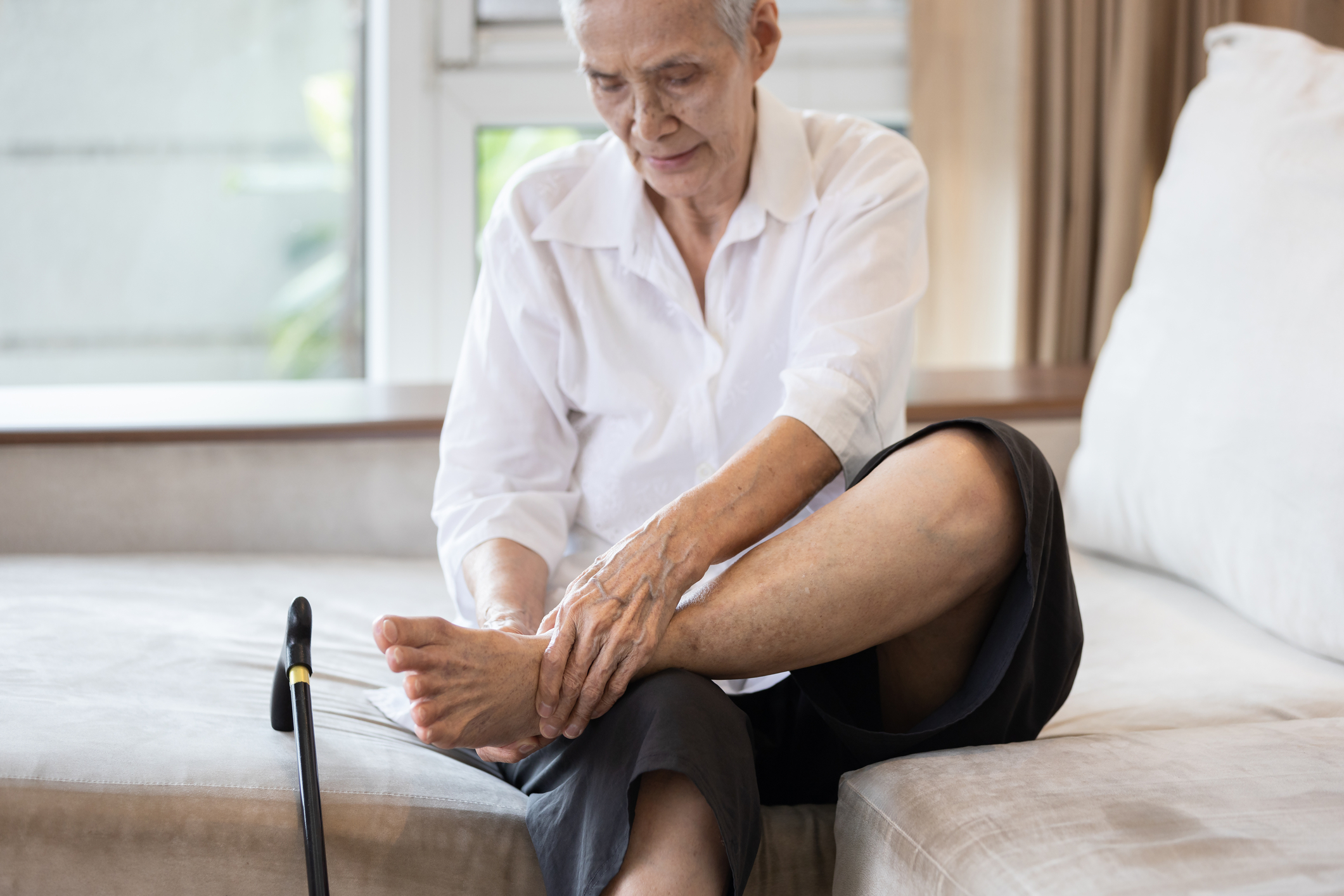
Hammertoe
One of the common causes of hammertoe in the elderly is an imbalance in the structure near the joint. A common culprit is wearing footwear that does not fit snugly. While the condition could be flexible during its initial stages, hammertoe can cause extreme foot pain in the elderly as it develops.
A few other causes that can trigger hammertoe in the elderly include longer toe length, improper footwear, genetics, age, and past injury. Moreover, certain health conditions, such as diabetes, muscle imbalance, inflammatory joints, or arthritis, can also cause the problem.
Symptoms of Hammertoe in the Elderly
If you or your elderly dear one is suffering from hammertoe, one of your toes will be in a bent position. You may have trouble straightening it or may not be able to unbend it at all. A few common symptoms include:
- Swelling in the feet.
- Trouble in walking.
- Calluses or corns on the middle joint of the hammertoe.
- Heel pain in the elderly or pain in the affected area.
- Foot pain at night in elderly.
Preventive Measures
Keep in mind that during the initial stages, the toe is still flexible, which means a few non-surgical techniques can prevent the toe from getting stuck in a bent position. Avoid narrow, tight, or high-heeled footwear if you or your elderly loved one is experiencing hammertoe. Instead, choose flat and low-heeled footwear. Open-toe shoes with a deep toe box can also help cure hammertoe.
Moreover, specific exercises, such as picking up light objects with toes, scrunching towels on the floor, and manually stretching the toe, can also prevent hammertoe.
However, if non-surgical treatment doesn’t alleviate the symptoms of hammertoe, your podiatrist may recommend tendon lengthening or arthrodesis surgery.
8. Bunions
Bunions are extremely painful bony lumps that can develop inside your or your elderly loved one’s feet near the joint where the big toe meets the foot. They grow gradually and force the big toe to bend inward. Bunions can disturb daily routine as they cause extreme foot pain in the elderly, making you or your loved ones housebound.

Bunions
While bunions are thought to be genetic, a few culprits can develop bunions in the elderly. For instance, an abnormal foot structure can trigger the problem. Additionally, specific conditions that can encourage the development of bunions include excessively flexible ligaments, flat feet, and abnormal bone structure.
While some people believe that footwear that doesn’t fit snugly can cause bunions, others think improper footwear can only worsen the existing structural issue.
Symptoms of Bunions in Elderly
In addition to the bumps, symptoms of bunions may include:
- Difficulty in moving the big toe.
- Calluses or corns on the second toe.
- Big toe bending towards other toes.
- Inflamed skin near the big toe.
- Hardened skin beneath the big toe.
- Foot pain at night in elderly.
Preventive Measures
Bunions can be treated through both surgical and non-surgical techniques. For non-surgical treatment, ensure to wear shoes with padded soles. Your footwear should also provide generous wiggle room for the toes. In addition, you can also seek the help of your podiatrist to pad or tap your affected foot into a normal position to decrease pressure on the bunion.
If the non-surgical measurement doesn’t help, your podiatrist may suggest surgical procedures to treat bunions. A common surgical procedure that can help treat bunions is bunionectomy.
Tips to Prevent Foot problems in elderly
Now that we have discussed common foot problems in elderly in detail, it’s time to know what feet care your elderly dear one needs to maintain mobility. Here are a few steps to help you avoid common problems like heel pain in the elderly or foot pain in the elderly.
- Inspect Feet Regularly: If you want to keep your or your senior dear one’s feet healthy, regular inspection of the feet is essential. Look for redness, cuts, blisters, swelling, sores, and other changes that can affect nails or feet skin.
- Seek the Help of a Podiatrist: Consulting with your pediatric surgeon can help you keep your feet in the best possible health. They offer a wide range of foot, ankle, and other foot structure-related treatments.
- Apply Lotion: If you or the elderly in your home are experiencing heel cracks or calluses, applying lotion daily can ease the foot pain at night in elderly while also improving the feet’ health. However, if you notice cracks between the toes, seek immediate help, as it could lead to severe infections.
- Choose Proper Footwear: A lot of common foot problems in elderly are caused by improper footwear. So, ensure your footwear offers enough room for your foot movement and fits snugly.
- Wear Clean, Dry Socks: In addition to proper footwear, wearing clean, dry socks made of wick-moisture can help prevent foot problems like fungus infection.
- Exercise Your Feet: Lastly, foot exercises involving stretches and resistance can help make your feet more flexible and robust.
Finding Ways to Help Relieve Foot Problems in Elderly Loved Ones
Common foot problems in the elderly, like fungus infection, bunions, stress fracture, etc., often limit your elderly loved one’s mobility and independence. So, taking care of feet is essential to stay active and independent. Knowing how to care for elderly feet can help prevent a lot of problems and let you enjoy your mobility and independence. We believe this post will help you understand what could go wrong with your feet as you age and what you can do to prevent it.
Foot problems are common in our elderly parents and often lead to a number of health complications if left untreated. In this post, we’ve outlined important tips for preventing and managing foot problems in your elderly parents. We hope you find these tips helpful, and please leave your comments and questions below. Thank you for reading!
You Might Also Like:
